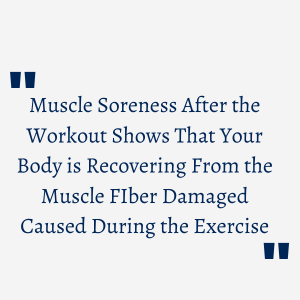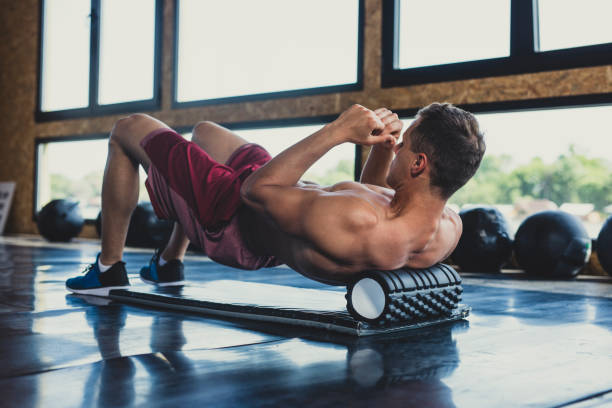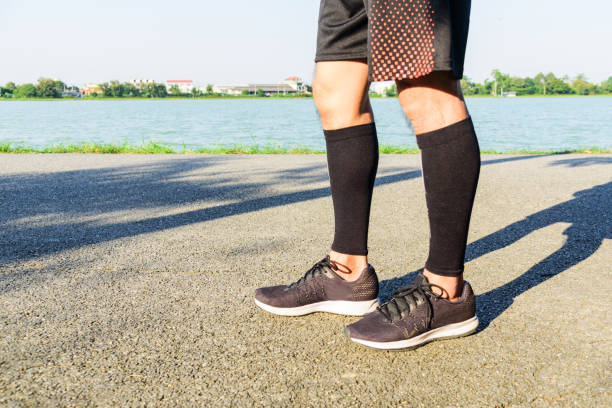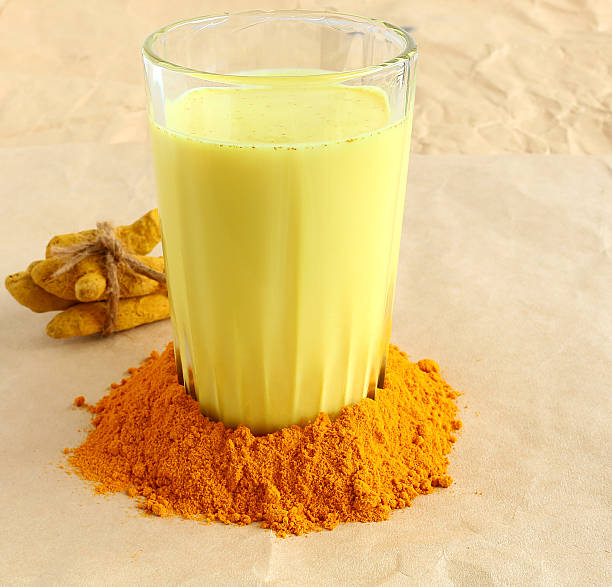Welcome to Fitness Deciphers…!!!
This is the most comprehensive guide on Muscle Soreness After the Workout.
Here, we will discuss almost everything about the muscle soreness that occurs after the workout.
Muscle soreness is the most common and frequent problem of many “Gym-goers”.
Whenever they exercise heavily, they suffer from muscle soreness the next day. This problem of sore muscles also spoils the workout of the next day.
Sometimes the intensity of the muscle soreness is so high that many people avoid exercising for many days and eventually quit the dream of bodybuilding.
So, to avoid such a situation, it is very important to cure or avoid muscle soreness so that it can’t become a road blocker for us in our journey of bodybuilding.
In this article, our focus will be on the different aspects of muscle soreness i.e, what it is, why it happens, its types, how to prevent and cure/treat muscle soreness, etc.
Let’s start.
Table of Contents
1. What is Muscle Soreness?
Muscle soreness is the side effect of the damage caused to the muscle fiber during the workout.
When muscle fiber gets damaged slight inflammation is produced in that area.
This inflammation causes pain and stiffness in the affected area.
Muscle soreness also shows that your body is healing the damaged fibers of the muscles.
2. Types of Muscle Soreness
1) Acute Muscle Soreness (AMS)
Acute Muscle Soreness (AMS) is also called immediate muscle soreness because it is felt during or immediately after the workout.
It is generally described as the burning pain which is caused by a buildup of metabolites in the muscle during a high-intensity workout.
The recovery of such muscle soreness is very quick.
2) Delayed Onset Muscle Soreness (DOMS)
DOMS is also called the post-workout muscle soreness. It is generally felt after 12-24 hours of doing the workout and needs 24-72 hours for a complete recovery.
It occurs from microscopic tearing of your muscle fibers and connective tissues surrounding them during exercise.
Generally, muscle soreness after the workout happens due to three reasons:
- Exercising for the first time
- Changing the exercises
- Increasing the intensity of exercises
Though there are two types of muscle soreness, you can still experience both types of soreness at the same time.
That’s why you are always advised to gradually increase the intensity of your workout and give proper rest to your body.
(Source: The American College of Sports Medicine)

3. Why Do Our Muscles Get Sore?
The actual process of muscle soreness is complex.
But in the easy language, you can understand that muscle soreness develops as a result of microscopic damage to muscle fibers that are involved in the exercise.
The eccentric muscle action in which muscles are stretched while the force is applied is the main reason for DOMS i.e, muscle soreness after a workout.
Such actions are the lowering phase of a bicep curl exercise or the stretching of the thigh muscles in walking, jogging, or running.
According to the university of south Carolina, when the muscle fibers get damaged due to exercises, your body starts the repair process by causing inflammation at the injured site.
This inflammation causes the sensation of tightness and pain in that area.
In short, muscle soreness that occurs after the workout is the side effect of the repair process that develops in response to the microscopic damage to the muscle fiber.

4. Factors On Which Intensity of The Muscle Soreness Depends
The intensity or the severity of the muscle soreness depends on the types of the force and the repetitions of the force.
When you completely stretch your arms while the lowering phase of the bicep curl then there is a great chance that the intensity of the soreness will be high.
If you increase the repetitions of any exercises then there is also a chance that the intensity of the muscle soreness will be high.
All people are susceptible to muscle soreness after the workout.
Even people who have been exercising for many years also feel muscle soreness after an intense workout.
However, the intensity of soreness generally becomes less as your body becomes adapted to working out regularly.
5. Is Muscle Soreness After the Workout Good?
As mentioned above that the muscle soreness after a workout indicates that your body has started healing the damage caused to the muscle fibers.
Just one round of soreness-causing exercise develops a partial protective effect that reduces the chance of developing soreness in that same activity for weeks or months into the future.
(Source: The Americal College of Sports Medicine)
So of course, soreness after exercising is good but this soreness should not last for longer periods.
Muscle soreness healed within 24-36 hours is a good indication that your body is able to heal muscle fibers which will also help you grow bigger and stronger muscles.
Now, we will discuss how to avoid muscle soreness and how to cure muscle soreness as fast as possible.
6. How to Cure or Avoid Muscle Soreness?
1) Start Slowly
If you are a newbie to the exercises or a regular gym-goer but thinking to increase the intensity then this is the best advice for you to avoid muscle soreness after the workout.
It is the problem of almost all beginners that they can’t wait to grow their muscles and start doing heavy exercises from day one.
It is completely wrong.
You should start exercising slowly so that your body can adapt to the new types of stress on the muscles.
Of course, you will definitely have muscle soreness but the intensity will be very low.
As your muscle starts getting adapted to the stress, you can slowly increase the repetitions or the intensity of the workout.
2) Give Proper Time to That Muscle to Recover
I have seen many people who keep on training their favorite muscles almost every day. It is completely wrong.
If you want to avoid muscle soreness then you have to give rest to that muscle. Repeating any particular muscle once a week or twice a week is good.
But don’t exceed it.
You should manage your exercise routine such that every muscle get the rest of 36-48 hours.
In a few weeks, your muscles will become strong enough and the chance of muscle soreness will become very less.
The bigger muscles such as the legs, chest, and back need more time to recover. So if you are a beginner then try to train them once a week only.
3) A Little Warm-up Before Workout may Help
There is little evidence that shows that warm-up helps in the reduction of muscle soreness.
But it is my personal experience that warm-up actually helps in the reduction of the severity of muscle soreness and prepares the body for the upcoming stress during the workout.
Many people do stretching exercises before a workout. But according to The Americal College of Sports Medicine, stretching should be done after warm-up and the main workout.
The Best Warm-up exercises to Practice Before The Workout:
- Fast walking
- Slow jogging
- Jumping jacks
- Jumping the rope
- Lifting light weights
4) Keep Yourself Hydrated After and During the Workout
It is very important to keep drinking water in small quantities during the workout.
Water keeps the fluids moving through the body, which provides relief from inflammation, flushes out waste products, and delivers nutrients to your muscles.
Sometimes it happens that you start to get dehydrated before you become thirsty. So it is better to note the color of your urine.
If it is dark yellow then you need more water and if it is transparent or pale yellow then it shows that you are hydrated.
(Check the color of your urine before the workout if it is dark yellow then first hydrate yourself and keep drinking water during the workout)
(Note: if you are taking any vitamin supplements then there is a chance that your urine color gets darker)
5) Massage Your Body
You can self-massage yourself or go to any massage parlor. Massage is one of the best ways to get relief from muscle soreness after a workout.
A good massage can relieve muscle tension and increase the blood flow throughout the body.
Don’t massage yourself hardly. You just need a light-pressure massage rather than the deep-tissued massage after a workout.
For smoothness, use oil while massaging yourself.
In summer coconut or sunflower oil is best and in winter, sesame or mustard oil is best.
You can also purchase the oil that is specially made to cure muscle soreness.
6) Consume Foods Before and After Working Out
Pre-workout and post-workout foods are booming…!!!
Pre-workout foods are generally rich in carbs whereas post-workout foods are rich in protein and carbs.
(Related: Best Pre-Workout Foods)
Consuming carbs before a workout provides you with enough energy for a workout. Whereas consuming protein is also beneficial for your muscles.
Why?
Because protein is made up of amino acids which are needed to rebuild the muscles. Protein helps in the faster recovery of the muscles.
According to experts, you should consume 20-40 grams of protein within 30 minutes of completing the exercise.
Also, you have to ensure enough intake of protein throughout the day.
According to the International Society of Sports Nutrition, if you do a heavy workout regularly then you should consume 1.4 to 2 g of protein per kilogram of your body weight.
7) Increase the Consumption of Vitamin C and Zinc
If you want a faster recovery from muscle soreness then you should start consuming vitamin C and zinc.
Vitamin C helps in the production of the protein called Collagen which boosts muscle recovery.
Rather than going for any supplements for vitamin C, you should focus on the consumption of citrus fruits because they are full of vitamin C.
Why Zinc?
Because zinc is associated with fast muscle recovery.
If you are a pro in bodybuilding then you might know about ZMA which is the short form of Zinc Magnesium Aspartate.
Many bodybuilders take zinc supplements because zinc is believed to boost muscle growth, improve endurance, fasten recovery, and sleep quality.
8) Have a Bath Using Warm Water
If you have ever tried having a bath using warm water after a workout then you know about that wonderful experience.
Having a bath with warm water is one of the ways to apply heat to your body.
Bathing with warm water improves the blood flow through the muscles which reduces the muscle tightness and feels you good.
To get the additional benefits, you can also add Epsom salt into the warm water.
Epsom salt tends to reduce muscle pain and inflammation.
9) Get Enough Sleep
Getting enough sleep is one of the best ways to avoid as well as cure muscle soreness after the workout.
Many people exercise a lot, they also consume a well-balanced diet but don’t take enough sleep which is wrong.
Always remember, you only exercise in the gym but the muscles are built only while you sleep. If you are exercising regularly then you should have a sleep of at least 7-8 hours.
A deep sleep increases the process of protein synthesis (production of new protein) which is extremely important for the recovery of damaged muscle fibers.
If you don’t take enough sleep then your muscles won’t get the proper rest and they will not be able to recover from soreness.
10) Use a Foam Roller or Massage Gun, Immediately After the Workout
There is a technique called Self-myofascial release (SMR) which is extremely beneficial to reduce muscle tension, and stiffness.
It also helps to move the fluids that accumulate in the muscle after exercise.
The foam roller and massage gun are the tools needed for the SMR techniques.
According to the report published by the International Journal of Sports Physical Therapy, foam rolling may help increase range of motion and reduce muscle soreness after the workout.
Foam rolling, as well as other types of massage, increases blood circulation to deliver more nutrients and oxygen to the affected area, which helps reduce inflammation and tenderness.
11) Wear a Compression Garment
Wearing a compression garment for 24 hours after exercise can reduce the intensity of muscle soreness and speed up the recovery of muscle function.
The main benefit of Compression garments is that they hold the muscles in place and increase blood flow which helps in faster recovery.
Compression garments for most muscle groups are available online as well as offline.
12) Consume Anti-Inflammatory Foods
Ginger, Pineapple, Cherries, Blueberries, Strawberries, Tomatoes, Olive oil, Green Leafy Vegetables, etc are some anti-inflammatory foods.
These foods are believed to provide relief from inflammation and eventually help in the reduction of muscle soreness.
Nuts such as almonds and walnut are also useful.
Fatty fish such as salmon, mackerel, tuna, and sardines can also help you recover from muscle soreness faster.
13) Warm Milk With Added Turmeric
When I was researching Indian Health Practices, I read about this wonderful remedy. I have personally tried and tested it on myself.
After getting the wonderful result I want to disclose it to you.
A glass of warm milk added with a pinch of turmeric literally help you cure or reduce the pain during muscle soreness.
It is because turmeric contains a compound called curcumin. It is high in antioxidants and has powerful anti-inflammatory effects.
So it can help a lot in the treatment of muscle soreness.
14) If Pain is More, Go For Cold Therapy
You ate protein, had a bath with warm water, did stretching after exercise, and warmed up before exercise but if you still have pain, then you should go for cold therapy.
Apply ice bags or ice packs to the paining area of the body. Cold therapy is said to provide relief from pain by reducing inflammation and nerve activity.
15) Don’t Quit Exercising
If you felt muscle soreness that means when you will exercise again, you will feel less soreness in your muscles.
Muscle soreness is just a natural process and reaction of your body to the sudden introduction of force to your muscles.
As you will exercise regularly, your body will be habituated to exercises and the severity of muscle soreness will drastically reduce.
16) Consult Your Doctor
Generally, you don’t need to visit or consult your doctor in case of muscle soreness. It is automatically healed in a few days.
But if the pain lasts for more than a week then you should consult your doctor.
This is all for this article. I would like to complete our discussion here.
Now, let me answer the most common questions.
FAQs
1) Should I start my workout with stretching to avoid muscle soreness after the workout?
According to modern research, you should start your workout with warm-up exercises rather than stretching. You can stretch after warming up and after your workout.
2) Is it possible to avoid muscle soreness?
If you are a beginner who is starting exercises or if you starting a new exercise schedule, then there is no way to avoid muscle soreness 100% effectively. It is a natural reaction of the body which indicates that your body is healing the damaged muscle fibers.
3) How many times should I train Hard in a week?
If you are a beginner then you can allot 2 days a week to train hard. As you become regular, you can increase the frequency of hard training.
4) Which herb can help you with muscle soreness?
Arnica is an herb that is used as a natural remedy to treat muscle soreness.
5) Should I work out with sore muscles?
No. You can train the other group of muscles rather than the sore one. You should give your muscles time to recover from soreness.
Conclusion
Here, we have discussed almost everything about muscle soreness after the workout.
If your muscles get sore after a workout, it is just a natural process and an indication that your body is healing the damaged muscle fibers.
It can take 3-4 days for the complete recovery in the beginning. But as you get habituated to exercises, the intensity of the soreness decreases.
If you feel pain even after a week then you can consult your doctor for further guidance.
If you have any questions related to this article, you can ask it in the comment box.
If you like this article then don’t forget to share it with your “GYM BUDDIES’.
Thanks for Reading…!!!





